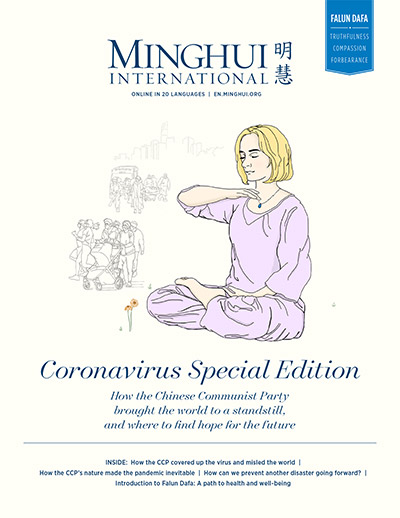[China Brief, a publication of the Jamestown Foundation]
The U.S. Census 2000 data revealed dramatic growth over the past ten years in the Chinese American population. In these years the Chinese-American community has increased by 48 percent to over 2.4 million, making it the largest Asian ethnic group in the country.
Notably, surveys have found that of this Chinese-American population, as many as 82.9 percent speak the Chinese language at home, with 60.4 percent professing that their English skills are limited (www.asianmediaguide.com). As one might expect, these people's dependence on Chinese-language media is heavy. And to a significant degree it is these media, as made available in the United States, that determine the worldview of many Chinese-Americans living in the States. Depictions of the democratic process, the rule of law, human rights and other American concepts come to Chinese-Americans through the filter of Chinese-language media. The content and nature of Chinese-language media (hereafter "Chinese media") in America thus deserves greater scrutiny.
Before 1985, Chinese media operations in the United States came primarily from Taiwan and Hong Kong, with little influence from Mainland China. This would change in the mid 1980s, however, when waves of immigration from Mainland China changed the profile of the Chinese-American community. The influx of Mainland Chinese piqued concerns of state-run media operations back home, triggering what can now be described as aggressive media efforts in the United States by Mainland operations. Indeed, the Mainland Chinese government has made major inroads into the Chinese media market here over the past decade.
Four main tactics characterize the Chinese government's effort to influence Chinese media in America. First is the attempt to directly control newspapers, television stations, and radio stations through complete ownership or owning major shares. Second is the government's use of economic ties to influence independent media who have business relations with China. This leverage has had major effects on the contents of broadcasting and publishing, effectively removing all material deemed "unfavorable" by the Chinese government. Third is the purchasing of broadcast time and advertising space (or more) from existing independent media. Closely related to this is the government's providing free, ready-to-go programming and content. Fourth is the deployment of government personnel to work in independent media, achieving influence from within their ranks.
These tactics have been applied with much effect to both national- and local-level Chinese media throughout the United States.
Influencing Chinese Newspapers
The dominant Chinese media vehicle in America is the newspaper. Four major Chinese newspapers are found in the U.S.: World Journal, Sing Tao Daily, Ming Pao Daily News and The China Press. With an alleged total circulation of over 700,000, these publications are regarded as indicators of the market's growth.
Of these four, three are either directly or indirectly controlled by the government of Mainland China, while the fourth (run out of Taiwan) has recently begun bowing to pressure from the Beijing government.
The China Press
Established in New York in January of 1990, The China Press is directly controlled by the Chinese government. The paper is characterized by its substantial and timely news reports from Mainland China. It represents the voice and views of China's Communist government.
Its daily issue averages some forty pages in length, and is distributed in almost all major U.S. cities. The paper claims a total circulation of 120,000.
Sing Tao Daily
Sing Tao Newspaper Group (STNG) was established in Hong Kong in 1938. In the 1960s regional offices were established in San Francisco, New York and Los Angeles to publish Sing Tao Daily in North America. In the late 1980s, STNG owner Sally Aw Sian met with financial crisis, and found a financial solution in the form of aid from the Chinese government. The past decade or so has seen the transformation of Sing Tao Daily into a pro-communist newspaper. Sally Aw Sian has since become a member of China's National Political Consultative Conference.
In January of 2001, the Global China Technology Group, a Hong Kong-based company chaired by Ho Tsu-Kwok, acquired the controlling shares of Sing Tao's holdings. Ho Tsu-Kwok, it should be noted, has close ties with Beijing and is currently also a member of China's National Political Consultative Conference. In May of 2001 Ho cooperated with China's state-run Xinhua News Agency to establish an information service company known as Xinhua Online.
Larry Lee (Li Ge), the deputy chief editor at Sing Tao's North America headquarters in San Francisco, is himself a former editor of China's People's Daily--the mouthpiece of the Chinese Communist Party. Li is in charge of the newspaper's editorial forum, Sing Tao Square. During the recent EP-3 incident, when two columnists published articles in Sing Tao asking China to release the American crew and return the U.S. airplane, they were singled out and attacked on Sing Tao Square for nearly a month. Similar situations have occurred following the publication of articles sympathetic to the Falun Gong spiritual practice.
Sing Tao Daily prints sixty-four pages in each issue and claims a circulation of 181,000.
Ming Pao Daily News
As preparation for Hong Kong's return to China in 1997, the Chinese government made vigorous attempts in the early 1990s to purchase several major media agencies in Hong Kong. This was done through the use of third-party merchants who have close business ties with China.
In October of 1995 Ming Pao Daily News was bought by a wealthy Malaysian merchant in the timber industry, Datuk Tiong Hiew King. As people guessed, Datuk had close business ties with China. Like Sing Tao, Ming Pao has since been heavily influenced by the Chinese government. For example, there is an unwritten rule at both Sing Tao and Ming Pao that no exclusive reports on the Pro-Democracy Movement of China are to be published. In order to appear to be "neutral" and "independent," they do however publish some related reports, but they are merely based on news releases from sources like the Hong Kong Information Center for Human Rights & Democratic Movement in China. Employees at Ming Pao's New York office have told sources that their "true boss" is none other than the Chinese Consulate [in New York], and that they are obligated to do whatever the Consulate asks.
Ming Pao claims a circulation of 115,000 and is distributed mainly on the east coast of the United States.
World Journal
An independently run daily publication, World Journal is one of the six branch-newspapers of the United Daily News (UDN)--Taiwan's most influential newspaper. World Journal is presently trying to develop business ties with Mainland China. The effects of this are already being felt, some persons report. For example, Chinese Consulates in both New York and San Francisco have pressured World Journal's local offices to not publish ads related to Falun Gong. The New York office has already acquiesced in full, and the San Francisco office has in part; it still prints Falun Gong ads, but with them appearing on the paper's least-viewed page 90 percent of the time.
World Journal is the most widely read Chinese-language newspaper in North America, and claims a circulation of 300,000 in the United States.
Influencing Chinese Television
The Chinese government of Mainland China has managed to influence Chinese-language TV in the United States, primarily by means of its China Central Television International station, or CCTV-4. CCTV is China's official state-run TV station.
Using digital compression technology, CCTV International offers Chinese programming twenty-four hours a day via satellite at no additional charge to viewers around the world, including those in the United States.
CCTV-4 also rents broadcasting time from influential independent TV stations across the United States, such as SinoVision in New York, which reaches millions of households and tens of thousands of Chinese viewers daily with its several broadcasting channels. Furthermore, CCTV-4 also provides free programming (especially news programs) to independent TV stations, ready for broadcast. Some of these stations also reach millions of households, such as Cable KPST 66 in San Francisco, which reaches 2.3 million households in the Bay area.
It is difficult to estimate the total number of viewers CCTV-4 has. First, its satellite broadcast signal is uncoded and can thus be received by any type of satellite dish; second, it runs on cable channels in most every U.S. city.
What this means is that CCTV-4 has effectively brought the Chinese Communist government's slanted news, or propaganda, to the vast majority of ethnic Chinese living in the U.S. Much of CCTV-4's broadcasting is identifiably anti-American even, and greatly at odds with reporting produced in the free world.
Concluding Thoughts
The 2000 Census also revealed that 80 percent of all Chinese-Americans live in twelve major U.S. cities. As one might by now expect, all these cities are targeted by the Chinese government with misinformation and propaganda. Not only are the above said papers and broadcasting to be found, but also, in almost every case, there are smaller, local newspapers, television stations and radio stations that are controlled by the Chinese government.
Beijing's government has thus penetrated U.S. markets to no small extent, having effectively infiltrated all major U.S. cities home to Chinese-Americans. Perhaps what should concern us most, though, is the nature of reporting that results from this. In most cases journalistic standards are clearly far below those of their English-language counterparts, with half-truths and even gross misinformation sometimes being panned as "news." Analysis of the reporting that takes place in this arena is in great need of careful examination, but of course beyond the scope of this article.
But for many of the United States' 2.4 million Chinese-Americans, such reporting might be all that they read, hear or see. Few or, in some cases, no alternatives exist. The "outside world" and current events are filtered and presented through a limited number of media, the majority of which are influenced--or even run, as we have now seen--by Beijing's communist government.
While there has been no formal analysis of such reporting's impact on Chinese-American communities, its long-term negative effects can nonetheless be surmised if not caught in glimpses. Startlingly apathetic responses to the September 11 tragedies are one recent indicator. Strong anti-American sentiments (especially notable among the Mainland Chinese communities in the United States) amidst the EP-3 affair and the Belgrade Embassy Bombing would be another. And fierce, even violent antagonism towards the Falun Gong on U.S. soil would also seem telling.
And, surprisingly, this would appear just the beginning. This past week it was reported that AOL Time Warner had closed a major deal with the Beijing government that would bring CCTV programming to the United States on a much larger scale, via Time Warner's cable operations. The U.S. government, by comparison, continues to have broadcasting rights in China flatly denied, instead finding its Radio Free Asia and Voice of America radio networks constantly jammed. Similarly, all major U.S. newspapers are banned in China and their websites blocked.
Mei Duzhe is a PRC Chinese scientist now teaching at a leading Western university.
China Brief is a publication of the Jamestown Foundation, a private nonprofit organization. Neither the Jamestown Foundation nor China Brief receives funding or support from any government or government agency.
http://www.jamestown.org/publications_details.php?volume_id=17&issue_id=638&article_id=4587
Category: Falun Dafa in the Media








